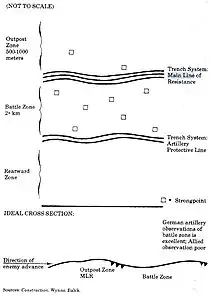Main line of resistance
A main line of resistance (MLR) is the most important defensive position of an army facing an opposing force over an extended front. It does not consist of one trench or line of pillboxes, but rather a system, of varying degrees of complexity, of fighting positions and obstacles to slow enemy advances.
Definition
The United States Department of Defense defines main line of resistance as follows:
A line at the forward edge of the battle position, designated for the purpose of coordinating the fire of all units and supporting weapons, including air and naval gunfire. It defines the forward limits of a series of mutually supporting defensive areas, but it does not include the areas occupied or used by covering or screening forces.[1]
History of concept

The term first came into use on the Western Front of World War I, after fighting became stalemated. On 1 December 1916, the German General Staff (Oberste Heeresleitung or OHL) published The Principles of Command in the Defensive Battle in Position Warfare, by two general staff officers, Hermann Geyer and Max Bauer, which described the principles of an elastic defense in depth.[2]
Under this concept, there were three zones: an outpost zone, a battle zone and a rearward zone. The lightly held outpost zone was there to provide warnings of attacks and repel enemy raids and patrols. Behind them was the main line of resistance, usually consisting of three successive trench lines. Where possible, the outpost zone was located on a forward slope and the main line on a reverse slope, obscured from direct observation by the enemy. Although this restricted the range of the defensive weapons, this was offset by the advantage of concealment, and the ability to surprise an attacker. The rearward zone consisted of another trench line 1,500 to 3,000 metres (4,900 to 9,800 ft) behind the MLR, depending on the terrain. It was not expected that the MLR could be held against a determined attack, only disrupt one, but a counterattack would be mounted from the rearward zone.[2] The German pamphlet was translated into English and adopted by the British Expeditionary Force for the defensive battles of 1918.[3]
During World War II, in which combat was relatively fluid, the term main line of resistance was used less often, and the positions the term described were usually less deep and complex than in World War I. However, there were exceptions, such as the French Maginot Line and Mareth Line,[4] the German Westwall (Siegfried Line to the Allies), and the Soviet Stalin Line.[5] After the Korean War became static in 1951, MLR described the defensive positions of the US Eighth Army, a series of trenches and bunkers extending east to west across the Korean peninsula.[6]
Notes
- Fry, Scott (31 October 2009) [12 April 2001]. Dictionary of Military and Associated Terms (PDF). Department of Defense. Joint Publication 1-02. Retrieved 17 October 2023.
- Lupfer, Timothy T. (1981). The Dynamics of Doctrine: The Changes in German Tactical Doctrine during the First World War (PDF) (Report). Leavenworth Papers. Fort Leavenworth, Kansas: Combat Studies Institute, US Army Command and General Staff College. pp. 11–13. OCLC 8189258. Archived (PDF) from the original on 4 March 2017 – via Archive Foundation.
- Bean, Charles (1937). The Australian Imperial Force in France during the Main German Offensive, 1918. Official History of Australia in the War of 1914–1918. Vol. V (8th ed.). Canberra: Australian War Memorial. pp. 35–36. OCLC 493141496.
- Kaufmann, J. E.; Kaufmann, H. W. (2006). Fortress France: The Maginot Line and French Defenses in World War II. Westport, Connecticut: Praeger Security International. pp. 72, 90–91. ISBN 978-0-275-98345-1. OCLC 61461623.
- Leeb, Wilhelm (1991). "Defense". Roots of Strategy, Book 3. Harrisburg, Pennsylvania: Stackpole Books. pp. 169–171. ISBN 978-0-8117-2194-3. OCLC 219854794.
- "The DMZ Campaigns". Defense POW/MIA Accounting Agency. Retrieved 17 October 2023.